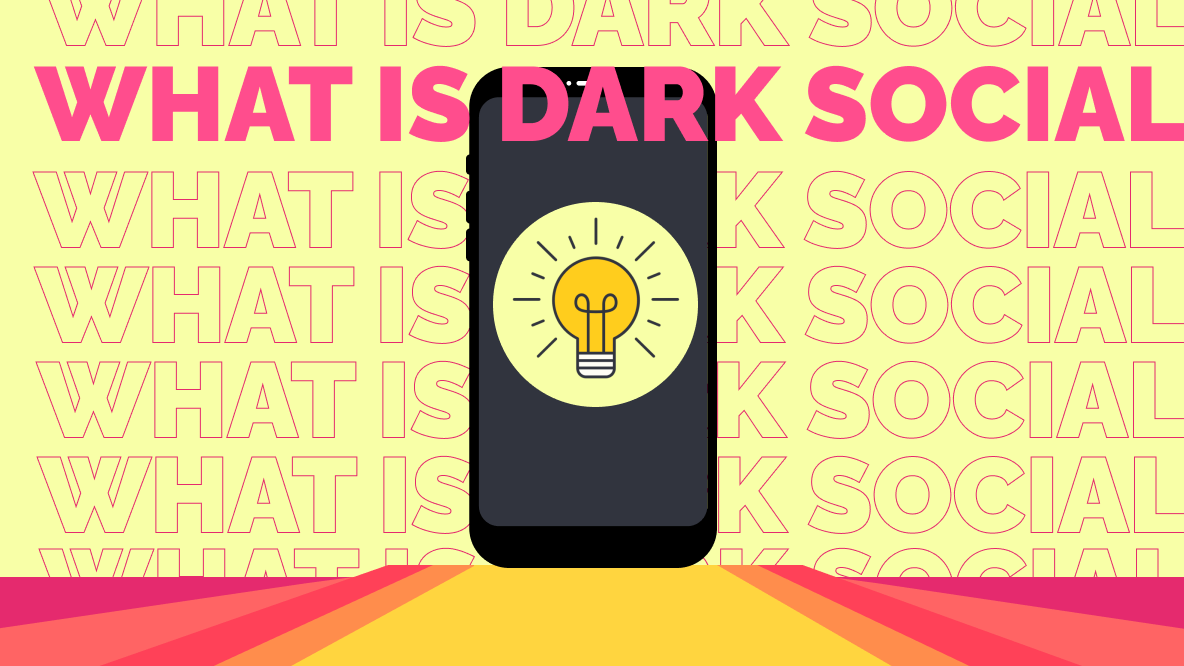Shining a Light on Dark Social: What Is It and How to Measure It?
Hard to track channels, like native social media posts and community chatter, often have huge impact on your awareness and conversion goals — even if they don't show up in your reporting dashboards. Learn about dark social, why it matters, and how to measure it.

How do you measure success in content marketing when your attribution data doesn’t tell the whole story?
Channels that are easy to track with attribution software, like paid ads, search, and on-site activity tend to be overrepresented in reporting. Smart marketers know, though, that just because you “have the data” doesn’t necessarily mean you’re drawing the right conclusions. In fact, misinterpreting or solely relying on certain sets of data does more harm than good.
Marketing channels that weren’t showing up in these attribution reports were often written off as awareness or vanity channels. Now, though, marketers are starting to come around to the concept of “dark social”—channels that underperform in attribution tracking software but actually play a large role in awareness and even conversion.
Let’s take a closer look at what dark social is, how to measure it, and why it matters for your video marketing strategy.
What is dark social?
“Dark social” is an umbrella term that encompasses any channels or platforms where you just can’t track things in the way you can on your own website.
Think about the places where potential customers are coming across your content, engaging with your brand, or having discussions about you or your product. Dark social includes offsite initiatives from your marketing team, like native social media, podcasts, etc., as well as community activity that’s entirely out of your control.
We typically see dark social broken down into the following three categories:
- Organic, offsite content. Traditional social media, podcasts, etc. Often the first awareness channels, but not credited in last-touch attribution or even first-touch attribution.
- Other brands’ channels. Off-site blog posts, newsletters, etc. It can be difficult to track attribution from spontaneous mentions of your brand or product in someone else’s email newsletter or blog post.
- Community channels. Digital word of mouth, shared in closed communities, like Slack channels or Discord servers. This can also include social DMs. You have almost no insight into who is talking about you or sharing your content in these spaces.
None of these are new channels, of course. So, why the sudden interest in dark social?
What’s driving the new investment in dark social?
There are four main catalysts we see pushing marketers to reconsider how they measure their content marketing efforts.
1. Platforms don’t want to send clicks off site: This has been true for a while, and it’s only becoming more of a problem. Just saying “link in bio” in a TikTok video can cost you views. Referral traffic from social media has plummeted over the last couple of years, according to new data from Axios.
While this study is charting the referral traffic to news sites specifically (and they track traffic closely), it’s representative of a larger trend: Social platforms are becoming less generous with referral traffic and the performance of link posts in general.
2. Analytics data has become muddier. This is a symptom of both high-level data privacy crackdowns – like the iOS 15 privacy update from Apple and the recent third-party cookie changes rolled out by Chrome and other browsers – and consumer-level privacy concerns, with a rise in ad blocker and VPN usage. You can’t collect the sort of data you used to.
3. Platforms are continuing to grow. With a few exceptions, social media platforms just keep getting bigger. Even compared to 10 years ago, there are more users and much more activity on (most) social platforms. This broadening of your potential audience makes tracking who’s seeing what that much more important.
4. Digital marketers are looking more closely at where data is really coming from. When dashboards and reports aren’t lining up with what their experience and intuition are telling them, digital marketers are starting to ask more pointed questions. Where is the revenue really coming from?
To help answer that question, the team at Refine Labs analyzed data on the inbound pipeline, comparing self-reported attribution (what customers say) versus software-based attribution (what your analytics platform says). They pulled this data over a 12-month period from a variety of businesses across different industries.
Their discovery was that these channels that classically under-perform with software-based attribution are showing up in self-reported attribution in a big way. They posited the measurement gap is as large as 90%.
The problem with software-based attribution (and self-reported, too!)
This data, along with many anecdotes from marketing teams, shows that we’re missing a lot of potential opportunities when we rely too heavily on traditional attribution tracking tools. The overperformance of search in these reports in particular is noteworthy, but there’s also the squishy “Other/Unknown” category which drops down to zero with self-reporting.
So, how do we compensate for attribution blind spots created by muddy data?
One straightforward way is to simply ask your prospects and customers, “Where did you hear about us?”
Of course, self-reported attribution has its own problems. Surveys of any kind are prone to bias and user error. And, ironically, prospects that engage with a lot of your content will probably have the hardest time remembering where they first encountered you.
The biggest issue, though, is this: The first touchpoint isn’t always the most important. That’s only a single point in the journey, and any attribution system that relies too heavily on any one point in time is never going to tell the full story.
Self-reported attribution isn’t a one-and-done replacement for software-based attribution. Instead, it’s a good way to counterbalance the fact that we know software tends to mostly give outsized credit to the last part of the attribution relay race.
Social is important, of course, but it’s also a long game. Sometimes, the customer journey on social is as simple as seeing an ad one time, clicking on it, and making a purchase on the website right then and there. But more often, it’s a series of interactions over weeks or months (or more!), giving you time to create content that people can actually enjoy and leading them back to you when they have a need for your product.
The move toward dark social is a call to focus on that harder to measure middle chunk.
Why video is key to dark social success
Betting on dark social means producing more organic and native social content, which is to say, native video content. There are a couple of compelling reasons why we think video is the key to successful dark social activation:
1. Video is the most shareable content form.
In 2023 (and beyond), video content is what performs best across nearly all social media platforms. Part of that is just based on infrastructure changes – people watch more video because their feed pushes more video content to them.
But also, people love sharing video.
In fact, they’re more likely to share video over anything else: image posts, text posts, blog posts, etc. And it’s not a slight preference for video. It’s significant.
According to this research from Wyzowl, 51% of people are more likely to share video over any other type of content. That’s nearly twice as popular as the next largest response, which is still social media.
Much of the value of dark social comes from users sharing content with each other, both on and off platform, so betting on video just makes sense.
2. Video lends itself well to multiple channels
There are so many more places to take a single piece of video content than a single piece of written content. You can break down a long-form video into several clips and publish them across multiple platforms in a way you can’t do with a blog post.
That’s what makes video an excellent anchor medium – but only if you pair it with an intentional repurposing strategy. Not just creating short-form content for the sake of it and posting clips at random.
Instead, consider video as the first place to share an idea. How do you share that idea in multiple places, so no matter where your prospects find you, they’re getting the same message.
Any repurposing formula should start with that idea first. Video is just the best medium for atomizing ideas and distributing them well.
Championing dark social in your own marketing
Dark social sounds nebulous and even a little ominous, but in reality, it’s just another way to connect with customers where they're already spending time and investigate how well your marketing efforts are actually working. If you’re seeing high engagement and reach with native video but it’s not showing up in the attribution data, ask questions before dismissing the approach.
Marketing attribution has always been about trying to triangulate your way to the truth. And the truth is, we may never be able to fully shine a light on the impact of dark social. But that shouldn't stop you from testing and directly asking users about their own customer journey; you might be surprised by what you learn.
Create content faster with Kapwing's online video editor →








